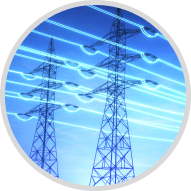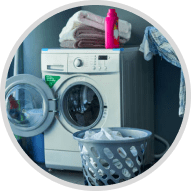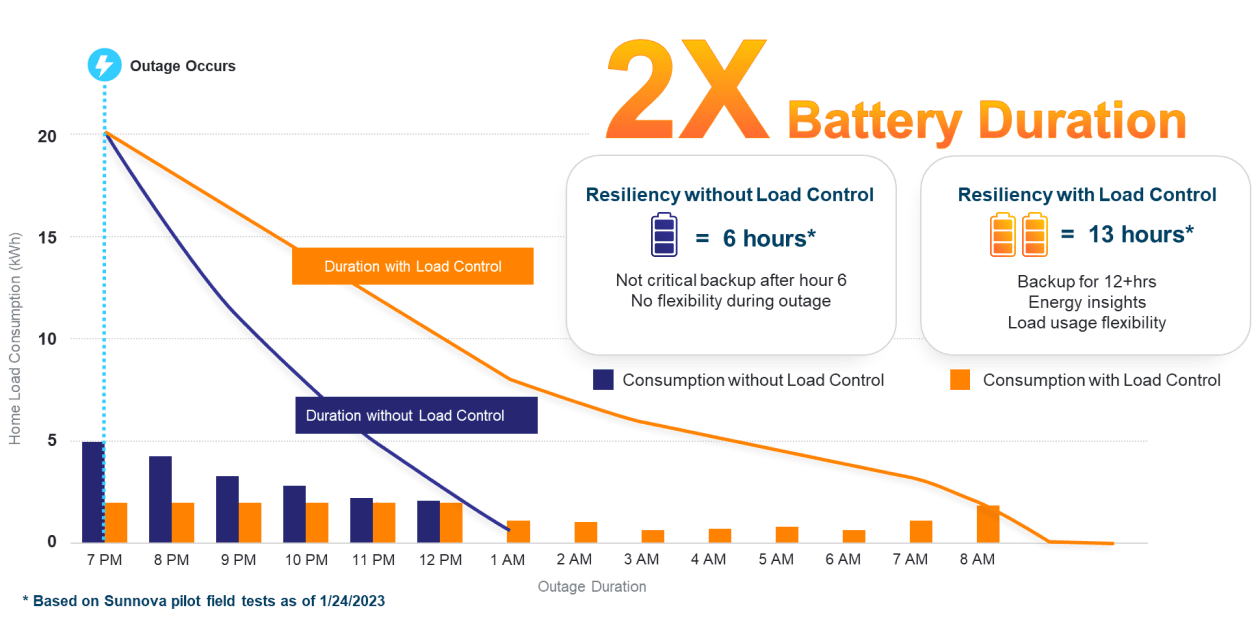

Work smarter, not harder. This productivity tip involves using your time more efficiently and prioritizing tasks to accomplish more with less effort. Not only does this motto apply to life, but it also applies to your home.
If you have solar panels with battery backup,* you’ll have a source of power if the grid goes down. But if you have a single solar battery, it will only last so long on a charge. What happens when a long-duration power outage hits, and your battery is drained halfway through the day? By nightfall, you may be sitting in the dark along with your neighbors who don’t have solar and storage.
You could buy a few more batteries, but that gets expensive.
Now there’s a way to prolong the power of your solar battery without the steep additional investment — with load control.
Through intelligent technology, a residential load controller gives you the ability to choose how your home consumes energy, enabling your power to stay on for up to twice as long during an outage.*
What is a Home Load Controller?

A load controller is a series of relays or automated switches that can control specific appliances in your home. This technology is wired into the circuits in your main electrical panel and acts like a second breaker that opens and closes to turn an entire circuit on or off. Think of it as an automated switching device that limits how much electricity your appliances can use at any one time. The relays are controlled by software programming that tells the switches what to do if a house loses power.
By allowing you to monitor and control the circuits connected to your appliances, load controllers let you choose what you want to remain powered during a grid outage. This is done by shutting off or ‘shedding’ the loads you can do without (your non-essential loads) to save your battery charge. Therefore, a home with load control can get through a longer-duration outage with the same battery storage capacity.
There are a variety of load controllers available in the U.S. today, featuring different design and installation configurations. But they all perform the same fundamental purpose: shedding loads via automated switching and extending the duration of your battery.
The Difference Between Partial and Whole-Home Backup
With traditional battery storage, you must choose a backup scenario to meet your household needs, as this dictates how your system will be wired.

Partial home backup
This setup utilizes two panels: one that is only connected to the grid (a non-backup panel) and one that is connected to the grid and your battery (a critical loads panel). Only the select few circuits wired to your critical loads panel will remain powered by your battery during an outage. Ideal for short-duration outages, partial home backup is the more cost-effective option as it requires minimal storage.

Whole-home backup
This setup allows all your appliances to maintain power during an outage. Ideal for longer and more frequent outages, whole-home backup lets you use your own power without relying on the grid, which enables you to make the most of your solar investment. This scenario provides an uninterrupted experience* but for a higher cost, as multiple batteries are typically needed to cover your home’s maximum energy consumption.
Deciding between the two backup options can be a tough decision. While partial home backup is better than sitting in the dark, a critical loads panel is small and can only handle appliances like well pumps, lighting, refrigeration, and outlets to run low-amp appliances. Larger and more energy-intensive appliances — dryers, water heaters, AC, ovens and stoves — fall into the non-critical loads category.
Adding load control to your solar plus storage system means you don’t have to choose one scenario over another. You can enjoy the benefit of whole-home backup for the cost of partial backup.
Load control is a critical component of the Sunnova Adaptive Home®, now available in select markets nationwide.
How Load Control Provides Whole-Home Backup at Partial Backup Costs
When a critical loads panel is installed for partial home backup, your battery is hardwired into it. This is done for safety reasons to make sure your battery never discharges higher than its specific rated power, as this will cause it to shut down.
A critical loads panel can’t be reconfigured unless you call an electrician to rewire it, which carries a hefty price tag. However, because load control is a software solution, it eliminates the need for this hardwired subpanel by creating a virtual backup loads panel. This means your solar battery can access all your circuits during a grid outage, giving you the benefit of whole-home backup.
Not all your circuits can be powered simultaneously (your battery’s rated power cannot change), so your system will have to shed loads to prevent your battery from becoming overloaded. But, since load control provides flexibility via software, you can decide which loads are most important before your home loses power, so you’re well-prepared.

Deciding Which Appliances to Control
The goal of load control is to have everything connected to your battery. Then, instead of controlling your essential loads, you want to control your non-essential and heaviest loads. By controlling them, you can turn them on and off.
Think about the appliances you want to remain on during an outage — refrigerator, interior lights, Wi-Fi router, deep freezer — those essential devices won’t be on load control. You’d want to start by turning off lower-priority devices like pool pumps and exterior lights, so these should be connected to load control relays.
Heavy loads like your HVAC should also be controlled. This appliance is great to have if there’s enough battery capacity to keep it running during an outage. However, if your battery’s state of charge is running low, you’ll want the option of turning it off to save that backup power for your essentials.
Load Categories
There are three main categories to which a load can be assigned. As you start prioritizing your appliances, think about which loads fall into each group.

Must-Have:
- Essential equipment that requires continuous operation
- Never connected to load control

Nice to Have:
- Dedicated circuits with high-consumption appliances
- Desirable but not crucial
- Paired with load control relays
- Either turn on and off during an outage or are programmed to shed automatically

Non-Essential:
- Circuits with unessential appliances or with consumption too large for the battery to support
- Paired with load control relays
- Automatically shut off during an outage
There are different programming options that customers can choose from. One configuration could be if a load controller detects an outage, it automatically shuts off the non-essential circuits. From there, as the battery’s state of charge drains, the desirable but not essential loads are shed.
Your specific load control scheme will depend on a number of factors, such as individual preferences, your total number of circuits, how your home is wired and the consumption of each circuit relative to the size of your solar and battery system.
Therefore, even though you have the same battery storage capacity, a load controller prolongs the effective charge for the circuits you care most about: your essential loads.
Arizona Simulation: With and Without Load Control
Sunnova performed a simulation using consumption data on a home in Arizona. The team analyzed the average annual consumption, calculated how long a battery would last on any given day, and labeled each load to determine how much energy it required. After applying the preconfigured settings, Sunnova effectively simulated the load shedding and determined that the storage capacity (energy in that charge) lasted more than twice as long with load control technology.


Invest in a Smarter Home
Load control technology is the missing link to energy independence. It’s a key component of the Sunnova Adaptive Home®, a whole-home energy management solution that connects multiple technologies to give you more control over the way your home produces and consumes energy.
When you add load control to your solar plus storage system, you’re investing in intelligent technology that enables your home to work smarter, not harder.
By prolonging your battery charge and giving you access to all your appliances when the grid fails, load control helps you stay comfortable at home no matter what happens outside.

